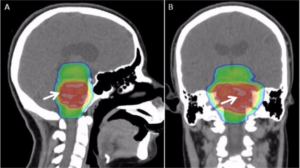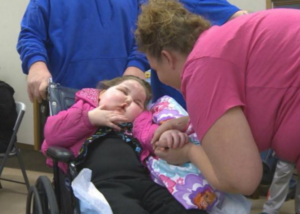
Cancer can be deadly to any child if not caught early enough.
But the worst cancer that a child can get is a particular type that no matter how early it’s caught, it will always kill the patient.
This cancer in children has a 100 percent fatality rate, though some kids have been known to survive it for three or four years following diagnosis.
“Diffuse intrinsic pontine glioma (DIPG) is arguably the most aggressive tumor in children,” says Jonathan Stegall, MD, an integrative oncologist and medical director for The Center for Advanced Medicine, an adult cancer treatment center in Alpharetta, GA.
“It is also very difficult to treat, as it occurs in the brainstem and can thus affect vital functions including breathing, heart rate and blood pressure.”
Diffuse Intrinsic Pontine Glioma
Sometimes, “intrinsic” is replaced with “infiltrating.” The common reference is DIPG.
There are many cancers that are nothing short of devastating to children and their parents, but even then, with those (such as osteosarcoma and lymphoma) there’s hope for a long-term survival – even well into adulthood.
But DIPG?
This is truly a monster for which treatment has not improved in over 40 years.
This is the worst cancer that a child can get when you consider survival odds and no advancements in treatment for decades.

DIPG. Source: Sison J, Tran H, Margol A, et al
What Is DIPG?
“This type of cancer is rare, occurring in roughly 300 children each year in the United States,” says Dr. Stegall.
However, over three times more U.S. children are killed every year by this lethal brain tumor than the average number of adults killed by terrorist attacks every year – between 1975 and 2015!
If we include the 9/11 attacks in the total number of U.S. citizens murdered by terrorists since 1975, that annual average comes out to 74.
Meanwhile, about 200 to 400 kids every year are diagnosed with DIPG. And this cancer WILL kill them.
DIPG Facts
• 10% of kids with DIPG are still alive two years after diagnosis.
• After five years it’s one percent.
• No adult walking this earth was diagnosed with DIPG as a young child.
• In very rare cases, within the rarity of this disease, some diagnoses are made on older teens and people in their early 20s and even 30s.
With that said, nobody age 40 who’s alive was ever diagnosed with DIPG.
• Average survival after diagnosis is nine to 12 months — when radiation treatment is given.
• No matter how early it’s caught, this doesn’t change the terminal nature.
• There is no such thing as “beating this thing” as a result of prayers, a warrior attitude or keeping one’s spirits up. DIPG is what it is: a ruthless killer that backs down to nothing (yet).
The Perfect Killer
When many people visualize a brain tumor, they think of a spherical or blob-shaped mass setting amid the brain matter, especially since tumor size is often compared to a golf ball, ping pong ball or tennis ball.
But extracting a DIPG surgically is not like plucking a golf ball out of brain tissue.
In the case of the worst cancer that a child can be diagnosed with, DIPG grows and sets diffusely within brain cells.
It cannot just be plucked out with surgical instruments. Imagine putting some shredded printing paper (symbolic of healthy brain tissue) into a bowl.
Add in wet tissue paper (symbolic of cancer). Now mix it up. Now see if you can pluck out the tissue paper without “damaging” the printing paper.
DIPG is inoperable for this reason – it’s diffusely amid brainstem tissue, rather than setting in there like a golf ball as a solid mass that can just be lifted out.
Initially most DIPG tumors respond to radiation by retracting, but at some point they “learn” to fight back and are unstoppable.
Chemotherapy never works.
The worst cancer that can strike a child may be exceptionally rare, but the statistics don’t matter to the parents.
Furthermore, if medical science could figure out a way to destroy DIPG, or at least cripple it enough to give patients many more years, imagine how this discovery would carry over to other cancers, especially adult brain tumors.
More Facts on the Worst Cancer for Children
• DIPG destroys everything (ability to move, eat, talk) except the ability to know what’s going on; kids at the educable age know what’s happening to them.
• Radiation is not a treatment per se; it’s a time-buyer – usually just three months.
• Proton beam therapy will not work; imagine trying to zap out all that wet tissue paper mixed in with the printing paper by using a pinpointed beam – without hitting any of the printing paper.
• The cause is not known and apparently not related to lifestyle or diet.
Wouldn’t it be great if next time you tuned into CNN, you saw a panel of analysts covering the latest advancements by world leaders – unified by a common goal – to wipe out DIPG and other cancers?
A discovery of how to combat it would open the doors to more effectively conquering other kinds of cancer in all age groups.
Let’s give this one more dose of perspective. When a U.S. commercial airliner crashes and kills all 250 people on board, headlines ripple for weeks while there is a massive and aggressive governmental investigation. And there should be.
About the same number of kids die every year from DIPG. Where is the massive and aggressive governmental investigation?
As one mother of a child with DIPG once said, “We live in an age where we spend billions of dollars to send satellites into space, and we don’t even get upset when they get lost! But 250 children die every year from a brain tumor, and we allow that to go on.”

 Jonathan Stegall, MD,
Jonathan Stegall, MD,
























